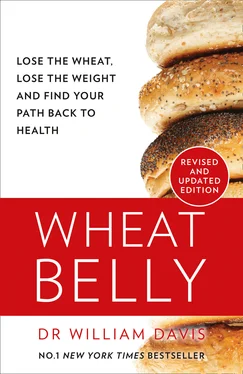So what are the effects of wheat on the vulnerable schizophrenic mind?
The earliest formal connection of the effects of wheat on the schizophrenic brain began with the work of physician F. Curtis Dohan, whose observations ranged as far as Europe and New Guinea. Dr. Dohan journeyed down this line of investigation because he observed that, during World War II, the men and women of Finland, Norway, Sweden, Canada, and the United States required fewer hospitalizations for schizophrenia when food shortages made bread unavailable, only to require an increased number of hospitalizations when wheat consumption resumed after the war was over. 1
Dr. Dohan observed a similar pattern in the hunter-gatherer Stone Age culture of New Guinea, Micronesia, and the Solomon Islands, where he was a member of a team of field researchers. Prior to Western influence, schizophrenia was virtually unknown, diagnosed in only 2 of 65,000 inhabitants in one New Guinea population previously unacquainted with Western ways. As Western eating habits infiltrated these populations and wheat products were cultivated, beer was made from barley, and corn was introduced, Dr. Dohan watched the incidence of schizophrenia skyrocket sixty-five-fold. 2On this background, he set out to develop the observations that established whether or not there was a cause-and-effect relationship between wheat consumption and schizophrenia.
In the mid-sixties, while working at the Veterans Administration Hospital in Philadelphia, Dr. Dohan and his colleagues decided to remove all wheat products from meals provided to schizophrenic patients without their knowledge or permission. (This was the era before informed consent of participants was required, before the infamous Tuskegee syphilis experiment became publicized that triggered public outrage and led to legislation requiring fully informed participant consent.) Lo and behold, four weeks sans wheat and there were distinct and measurable improvements in the hallmarks of the disease: a reduced number of auditory hallucinations, fewer delusions, less detachment from reality—they weren’t cured, but just showed less severe signs of schizophrenia. Psychiatrists then added the wheat products back into their patients’ diets and the hallucinations, delusions, and social detachment rushed right back. Remove wheat again, patients and symptoms got better; add it back, they got worse. 3
The Philadelphia observations in schizophrenics were corroborated by psychiatrists at the University of Sheffield in England, with similar conclusions. 4There have since even been reports of complete remission of the disease, such as the seventy-year-old schizophrenic woman described by Duke University doctors, suffering with delusions, hallucinations, and suicide attempts with sharp objects and cleaning solutions over a period of fifty-three years, who experienced complete relief from psychosis and suicidal desires within eight days of stopping wheat. 5
While it seems unlikely that wheat exposure caused schizophrenia in the first place, the observations of Dr. Dohan and others suggest that wheat is associated with measurable worsening of symptoms. In the years since Dr. Dohan’s early observations, the explosion of more recent investigations suggests that consumption of gluten-containing foods is associated with increased intestinal permeability, or “leakiness,” along with alterations in the bowel microbiome that underlie the troublesome mind pathology of schizophrenia. 6Modern observations also corroborate Dohan’s observations with dramatic reversal of schizophrenic phenomena within days to weeks of gluten removal, even after years of unremitting symptoms. 7It has also become clear that celiac disease and schizophrenia are two different varieties of grain-induced disease and the psychotic behavior of schizophrenia can occur independently of celiac disease. 8
Another condition in which wheat may exert effects on a vulnerable mind is autism. Autistic children suffer from impaired ability to interact socially and communicate. The condition has increased in frequency over the past forty years, from rare in the mid-twentieth century to 1 in 150 children in the twenty-first. 9Initial small samples have demonstrated improvement in autistic behaviors with gluten removal. 10, 11The most comprehensive clinical trials to date with formal measures of autistic behavior have demonstrated improvement with gluten elimination (sometimes combined with elimination of casein from dairy and a variety of different nutritional supplements). 12, 13, 14
While it remains a topic of debate, a substantial proportion of children and adults with attention deficit/hyperactivity disorder (ADHD) may also respond to elimination of wheat. However, responses are often muddied due to sensitivities to other components of diet, such as sugars, artificial sweeteners, additives, and dairy. 15
It is unlikely that wheat exposure was the initial cause of autism or ADHD but, as with schizophrenia, wheat appears to be associated with worsening of the symptoms characteristic of these conditions.
Though the laboratory rat treatment of the unsuspecting schizophrenic patients in the Philadelphia VA Hospital may send chills down our spines from the comfort of our fully informed and consenting twenty-first century, it is nevertheless a graphic illustration of wheat’s effect on mental function. But why in the world are schizophrenia, autism, and ADHD exacerbated by wheat? What is in this grain that worsens psychosis, prompts hearing voices and other abnormal behaviors?
Investigators at the National Institutes of Health (NIH) set out to find some answers.
EXORPHINS: THE WHEAT-MIND CONNECTION
Dr. Christine Zioudrou and her colleagues at the NIH subjected gluten, the main protein of wheat, to a simulated digestive process to mimic what happens after we eat bread or other wheat-containing products. 16Exposed to pepsin (a stomach enzyme) and hydrochloric acid (stomach acid), gluten is degraded to a mix of polypeptides. (Unlike the proteins in, say, eggs or pork chops that are broken down into single amino acids, the proteins of wheat are either indigestible or only digestible to polypeptides, small chains of amino acids, because humans lack the digestive enzymes to break down the components of seeds of grasses.) The dominant polypeptides were then isolated and administered to laboratory rats. These polypeptides were discovered to have the peculiar ability to penetrate the blood-brain barrier that separates the bloodstream from the brain. This barrier is there for a reason: The brain is highly sensitive to the wide variety of substances that gain entry to the blood, some of which can provoke undesirable effects should they cross into your amygdala, hippocampus, cerebral cortex, or other brain structure. Once having gained entry into the brain, wheat polypeptides bind to the brain’s morphine receptors, the very same receptors to which opiate drugs like fentanyl and oxycodone bind.
Zioudrou and her colleagues dubbed these polypeptides “exorphins,” short for exogenous morphine-like compounds, distinguishing them from endorphins, the endogenous (internally sourced) morphine-like compounds that occur, for instance, during a “runner’s high.” They named the dominant polypeptide that crossed the blood-brain barrier “gluteomorphin,” or morphine-like compound from gluten. The investigators speculated that exorphins might be the active factors derived from wheat that account for the deterioration of schizophrenic symptoms seen in the Philadelphia VA Hospital and elsewhere.
Even more telling, the NIH group found that the brain effects of gluten-derived polypeptides are blocked by administration of the opiate-blocking drug naloxone.
Let’s pretend you’re an inner-city heroin addict. You get knifed during a drug deal gone sour and get carted to the nearest trauma emergency room. Because you’re high on heroin, you kick and scream at the ER staff trying to help you. So these nice people strap you down and inject you with a drug called naloxone, and you are instantly not high. Through the magic of chemistry, naloxone immediately reverses the action of heroin or any other opiate drug such as morphine or oxycodone.
Читать дальше












